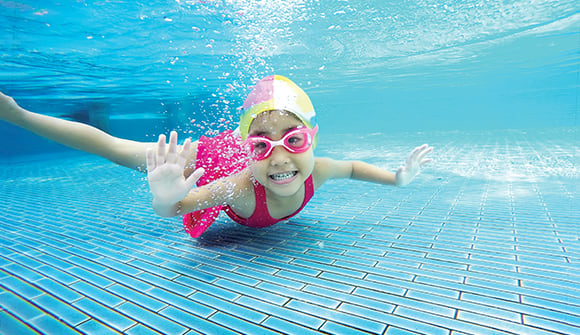Swim style
What children should (and shouldn’t) wear in water.
Article Author: Juliette Allen
Article Date:

It’s no secret that Florida summers are scorchers. As temperatures soar, families flock to pools, beaches and lakes to get a much-needed reprieve from the heat.
According to Jessica Winberry, prevention coordinator for Safe Kids Northeast Florida, which is led by THE PLAYERS Center for Child Health at Wolfson Children’s Hospital, what your child wears could boost their chances of staying safe in the water.
Are floaties safe for kids?
Parents of children who are too young to swim often turn to flotation devices to help their tots enjoy the water. However, some of these products could do more harm than good.
“If a child slips out of their floats or if their water wings pop, they’re at risk for drowning,” Winberry explained. “Additionally, a child who can maneuver successfully with floaties may overestimate their true ability to swim.”
Many of the popular floaties keep children in a vertical position, which they may get accustomed to. The problem is, children need to be horizontal in order to swim or float.
“Drowning often occurs during ‘non-swim’ times,” Winberry said. “It tends to happen after parents or caregivers have taken children away from the swim area and changed them out of their bathing suits, yet the child finds their way back to the pool and either goes in on their own or falls in.”
In general, parents should stick to flotation devices that are approved by the U.S. Coast Guard and steer away from:
- Water wings
- Non-Coast Guard-approved floats
- Inflatable products
Bright sight
Children of all ages – from toddlers to teens – can have some strong opinions on what they wear. Although you can leave the swimsuit style to the experts, there are some recommended colors for maximum visibility.
Bright and neon shades of the following colors are easiest to spot in water:
- Orange
- Yellow
- Pink
- Green
On the other hand, children wearing these colors may blend in with the water and be harder to spot:
- White
- Light blue
While darker-colored swimsuits may be easy to see in a pool, they could be harder to spot in open bodies of water like oceans and lakes.
Nothing replaces supervision
While being mindful about what children wear in the pool can help boost overall safety, Winberry cautioned that accidents can happen unexpectedly, and even older kids and strong swimmers can drown.
That’s why it’s important to have layers of protection in place, such as:
- Never leaving a child alone around water.
- Using door and/or window alarms to signal if someone exits the home.
- Installing fencing with child locks around home pools.
- Starting swim lessons as early as age 1 and continuing throughout childhood.
- Using only Coast Guard-approved flotation devices.
- Learning CPR.
“No matter where you are with your child, it’s important to have the same layers of protection in place,” Winberry said. “Your home may have all the safety precautions, but you can’t guarantee somewhere else will. Also, children may want to explore a new place, so it’s especially important to watch them vigilantly.”
For more water safety tips from Safe Kids Northeast Florida, which is led by THE PLAYERS Center for Child Health at Wolfson Children’s Hospital, click here. To search for U.S. Coast Guard-approved flotation devices, click here.



